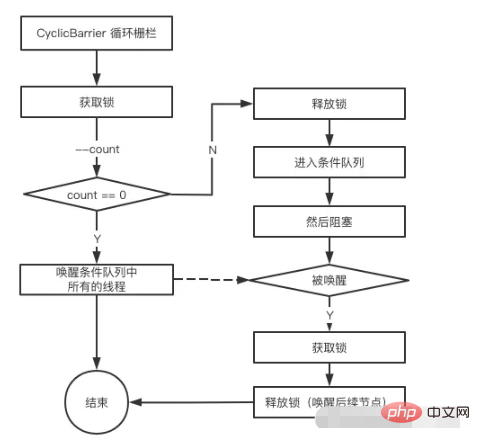
CyclicBarrier literally means loop barrier (cyclic barrier). It can make a group of threads wait for a certain state (barrier point) and then execute them all at the same time. It is called loopback because CyclicBarrier can be reused after all waiting threads are released.

The function of CyclicBarrier is to make a group of threads wait for each other. When a common point is reached, all previously waiting threads will continue to execute, and the CyclicBarrier function can be reused.
Construction method:
// parties表示屏障拦截的线程数量,每个线程调用 await 方法告诉 CyclicBarrier 我已经到达了屏障,然后当前线程被阻塞。 public CyclicBarrier(int parties) // 用于在线程到达屏障时,优先执行 barrierAction,方便处理更复杂的业务场景(该线程的执行时机是在到达屏障之后再执行)
Important method:
//屏障 指定数量的线程全部调用await()方法时,这些线程不再阻塞 // BrokenBarrierException 表示栅栏已经被破坏,破坏的原因可能是其中一个线程 await() 时被中断或者超时 public int await() throws InterruptedException, BrokenBarrierException public int await(long timeout, TimeUnit unit) throws InterruptedException, BrokenBarrierException, TimeoutException //循环 通过reset()方法可以进行重置
Using CyclicBarrier can be used in scenarios where multi-threaded data is calculated and the calculation results are finally merged.
Using the feature of CyclicBarrier that the counter can be reset and the barrier can be reused, it can support scenarios similar to "full departure"
Using CyclicBarrier can be used to calculate data in multiple threads and finally merge the calculation results.
public class CyclicBarrierTest2 { //保存每个学生的平均成绩 private Conc urrentHashMap map=new ConcurrentHashMap(); private ExecutorService threadPool= Executors.newFixedThreadPool(3); private CyclicBarrier cb=new CyclicBarrier(3,()->{ int result=0; Set set = map.keySet(); for(String s:set){ result+=map.get(s); } System.out.println("三人平均成绩为:"+(result/3)+"分"); }); public void count(){ for(int i=0;i<3;i++){ threadPool.execute(new Runnable(){ @Override public void run() { //获取学生平均成绩 int score=(int)(Math.random()*40+60); map.put(Thread.currentThread().getName(), score); System.out.println(Thread.currentThread().getName() +"同学的平均成绩为:"+score); try { //执行完运行await(),等待所有学生平均成绩都计算完毕 cb.await(); } catch (InterruptedException | BrokenBarrierException e) { e.printStackTrace(); } } }); } } public static void main(String[] args) { CyclicBarrierTest2 cb=new CyclicBarrierTest2(); cb.count(); } }
Using the characteristics of CyclicBarrier's counter can be reset and the barrier can be reused, it can support scenes similar to "the bus is full of people"
public class CyclicBarrierTest3 { public static void main(String[] args) { AtomicInteger counter = new AtomicInteger(); ThreadPoolExecutor threadPoolExecutor = new ThreadPoolExecutor( 5, 5, 1000, TimeUnit.SECONDS, new ArrayBlockingQueue<>(100), (r) -> new Thread(r, counter.addAndGet(1) + " 号 "), new ThreadPoolExecutor.AbortPolicy()); CyclicBarrier cyclicBarrier = new CyclicBarrier(5, () -> System.out.println("裁判:比赛开始~~")); for (int i = 0; i < 10; i++) { threadPoolExecutor.submit(new Runner(cyclicBarrier)); } } static class Runner extends Thread{ private CyclicBarrier cyclicBarrier; public Runner (CyclicBarrier cyclicBarrier) { this.cyclicBarrier = cyclicBarrier; } @Override public void run() { try { int sleepMills = ThreadLocalRandom.current().nextInt(1000); Thread.sleep(sleepMills); System.out.println(Thread.currentThread().getName() + " 选手已就位, 准备共用时: " + sleepMills + "ms" + cyclicBarrier.getNumberWaiting()); cyclicBarrier.await(); } catch (InterruptedException e) { e.printStackTrace(); }catch(BrokenBarrierException e){ e.printStackTrace(); } } } }
Output result:
Player No. 3 is in place, ready to share: 78ms0
3. CyclicBarrier source code analysis
Player No. 1 is in place, ready to share: 395ms1## Player No. 5 is in position, ready to share: 733ms2 Player No. 2 is in position, ready to share: 776ms Player No. 3
is in position, ready to share: 807ms4
Referee: The game has started ~~
4 players are in place, ready to share: 131ms0
3 players are in place, ready to share: 256ms1
2 players are in place, ready to share: 291ms2
Player No. 1 is in place, ready to share: 588ms3
Player No. 5 is in place, ready to share: 763ms4
Referee: The game begins~~

 #A few common questions?
#A few common questions?
Wake up all nodes on the condition queue.
CyclicBarrier implements the blocking and awakening of a group of threads through ReentrantLock's "exclusive lock" and Conditon, while CountDownLatch is implemented through the "shared lock" of AQS
The above is the detailed content of How to apply CyclicBarrier cycle barrier in Java. For more information, please follow other related articles on the PHP Chinese website!




